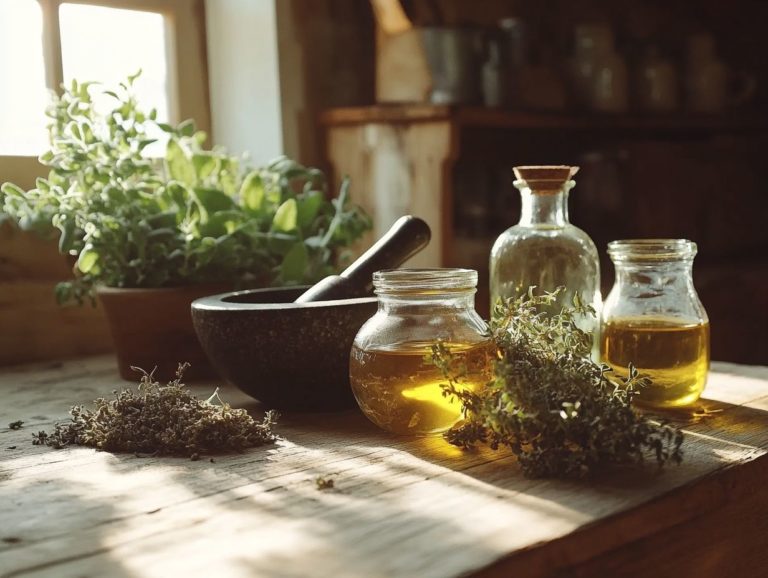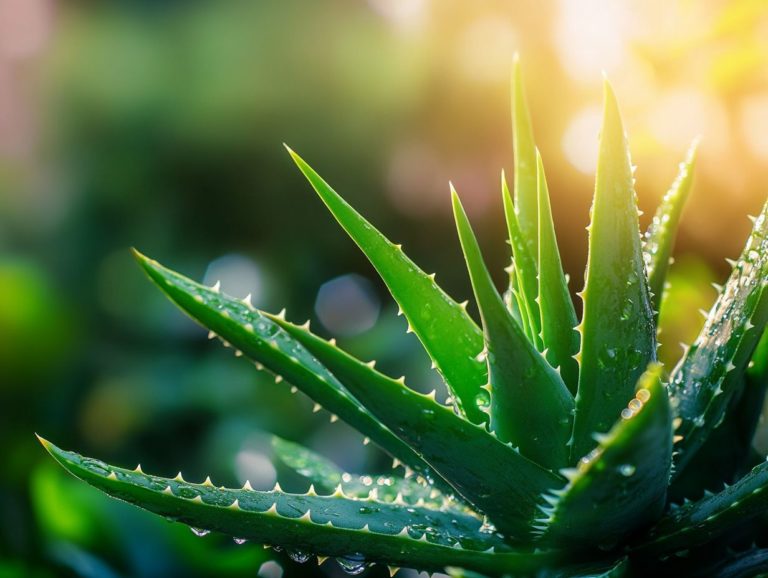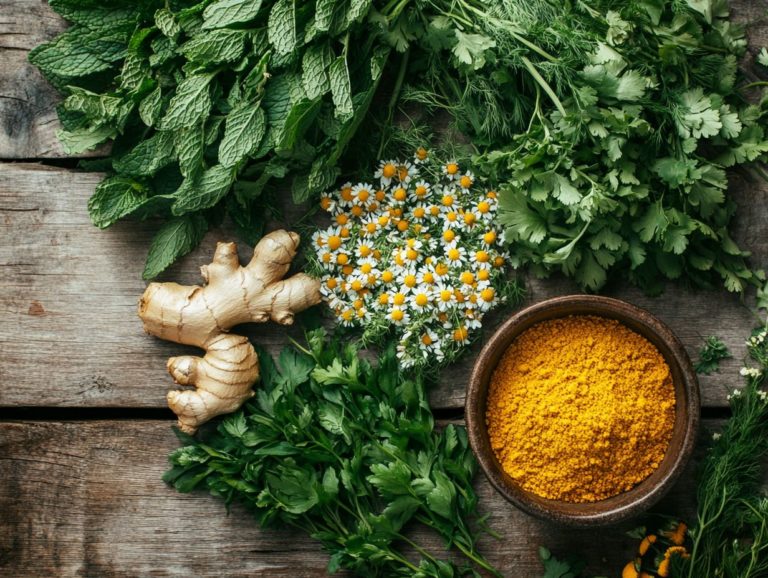The Healing Powers of Peppermint
Peppermint is not merely a refreshing flavor; it s a herb steeped in rich history, brimming with health benefits, and exuding remarkable versatility.
In this article, you ll explore the fascinating origins of peppermint, uncover its impressive physical and mental health advantages, and discover practical methods to weave it seamlessly into your daily routine.
From topical applications to internal consumption, discover essential precautions you must know, along with tips for cultivating this aromatic gem. Immerse yourself and uncover the healing powers peppermint has to offer!
Contents
- Key Takeaways:
- What is Peppermint?
- Health Benefits of Peppermint
- Ways to Use Peppermint
- Precautions and Side Effects
- Growing and Harvesting Peppermint
- Frequently Asked Questions
- What are the healing powers of peppermint?
- How does peppermint help with digestion?
- Can peppermint help with headaches?
- In what forms can peppermint be consumed for its healing powers?
- Are there any potential side effects of using peppermint for its healing powers?
- Can peppermint be used for topical applications?
Key Takeaways:
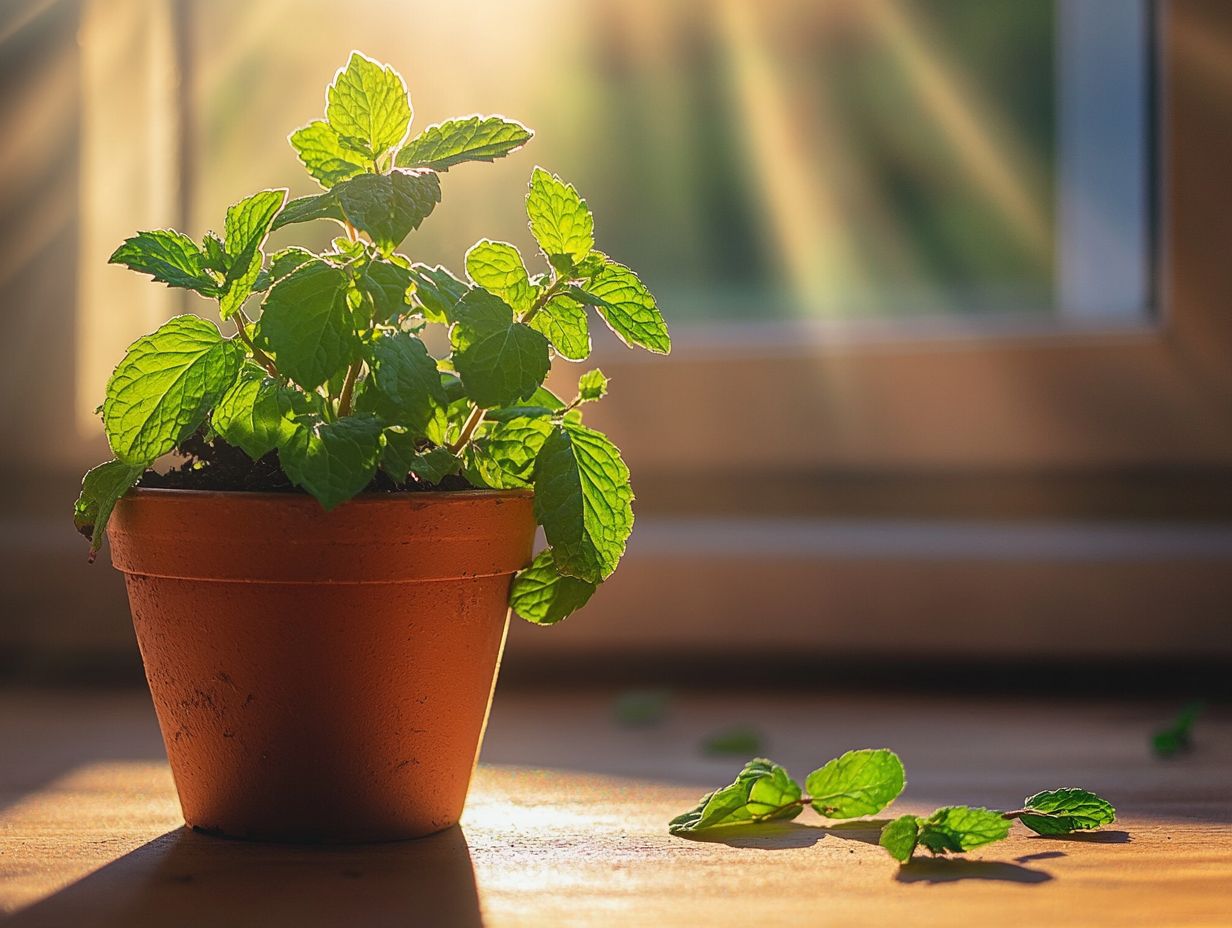
- Peppermint has a rich history and has been used for its healing properties for centuries.
- Peppermint offers many health benefits, including relief from digestive issues, headaches, and stress.
- There are various ways to use peppermint for its healing properties.
What is Peppermint?
Peppermint, an aromatic herb from the mint family, delights your senses with its unmistakable flavor and invigorating aroma, largely thanks to its high menthol content.
This herb’s fascinating history stretches back to ancient civilizations, including Egypt, Greece, and Rome, where it was prized not just for its culinary uses but also for its potential medicinal benefits.
With such a rich legacy and remarkable versatility, peppermint stands as a cornerstone in both culinary arts and herbal remedies, presenting you with an array of health benefits to explore.
Brief History and Origins
The history of peppermint stretches back to ancient civilizations, where its cultivation and use flourished in places like Ancient Egypt, Greece, and Rome.
This aromatic herb was treasured for its refreshing scent and an array of medicinal properties. The Ancient Egyptians utilized peppermint not only in their embalming rites but also as a flavoring agent. Meanwhile, the Greeks and Romans embraced it in their food, wine, and even cosmetics, fully aware of its digestive benefits.
As the centuries rolled on, peppermint’s popularity expanded across Europe and Asia, transitioning from a mere garnish to an essential ingredient in medicinal blends, culinary delights, and aromatic therapies. Today, it stands celebrated not just for its culinary versatility but also for its vital role in modern herbal medicine, showcasing the enduring legacy of this remarkable plant.
Health Benefits of Peppermint
Peppermint is celebrated for its myriad health benefits, offering relief from a range of ailments such as digestive issues, a condition that causes stomach pain and changes in bowel habits, nausea, headaches, muscle pain, and seasonal allergies. Its essential oil, infused with menthol and other beneficial compounds, boasts antimicrobial properties, making it a preferred option in herbal remedies.
Numerous studies indicate that peppermint can significantly alleviate digestive symptoms and enhance your overall well-being.
Physical and Mental Health Benefits

Peppermint presents an array of physical and mental health benefits, scientifically recognized for its ability to alleviate nausea, headaches, and digestive discomfort while also combating mental fatigue.
Incorporating peppermint oil into your aromatherapy routine can elevate your relaxation and enhance mental clarity. The invigorating scent has a remarkable way of lifting your spirits and sharpening your focus.
For those experiencing localized pain, applying diluted peppermint oil topically can provide cooling relief from muscle tension and headaches.
Sipping on peppermint tea not only soothes your stomach but may also support overall digestive health, creating a calming ritual that helps alleviate stress and anxiety. This versatile herb thus plays multiple roles, acting as both a soothing remedy for physical ailments and a refreshing mental boost in your daily life.
Try incorporating peppermint into your routine today and experience its wonderful benefits!
Ways to Use Peppermint
You have a variety of effective options for incorporating peppermint into your routine. Consider topical applications for refreshing relief, internal consumption for digestive support, or brewing a delightful cup of peppermint tea. Each method provides its own distinct benefits.
Topical Applications
Topical applications of peppermint oil can be your go-to natural remedy for skin irritation and muscle pain. It offers a delightful cooling effect thanks to its menthol content.
This essential oil has a rich history in traditional medicine for alleviating discomfort. Modern studies back up its effectiveness. When you dilute it with a carrier oil (a base oil used to dilute essential oils) like coconut or jojoba, it s perfectly safe to apply to those pesky areas. This dilution provides relief for headaches or minor skin irritations.
Many users rave about the soothing sensation that helps ease muscle tension and promotes relaxation. Just remember to perform a patch test first to rule out any allergic reactions. This way, you can enjoy a safe and rewarding experience with this versatile oil.
Internal Consumption
Internal consumption of peppermint, whether through tea or capsules, serves as a remarkable ally in promoting digestive relief and aiding appetite control. It’s a critical choice for your wellness journey.
Incorporating peppermint into your diet unlocks a wealth of health benefits. Peppermint tea, in particular, is renowned for its soothing properties. It effectively alleviates common digestive issues like bloating and gas. The warm infusion stimulates bile production, enhancing the breakdown of fats.
Alternatively, peppermint capsules provide a convenient option, delivering concentrated doses that target stomach problems with precision. Both methods are effective due to menthol, a compound known for relaxing the muscles of the gastrointestinal tract.
These natural remedies not only ease indigestion but also bolster overall digestive health. This establishes peppermint as a vital addition to your wellness routine.
Precautions and Side Effects
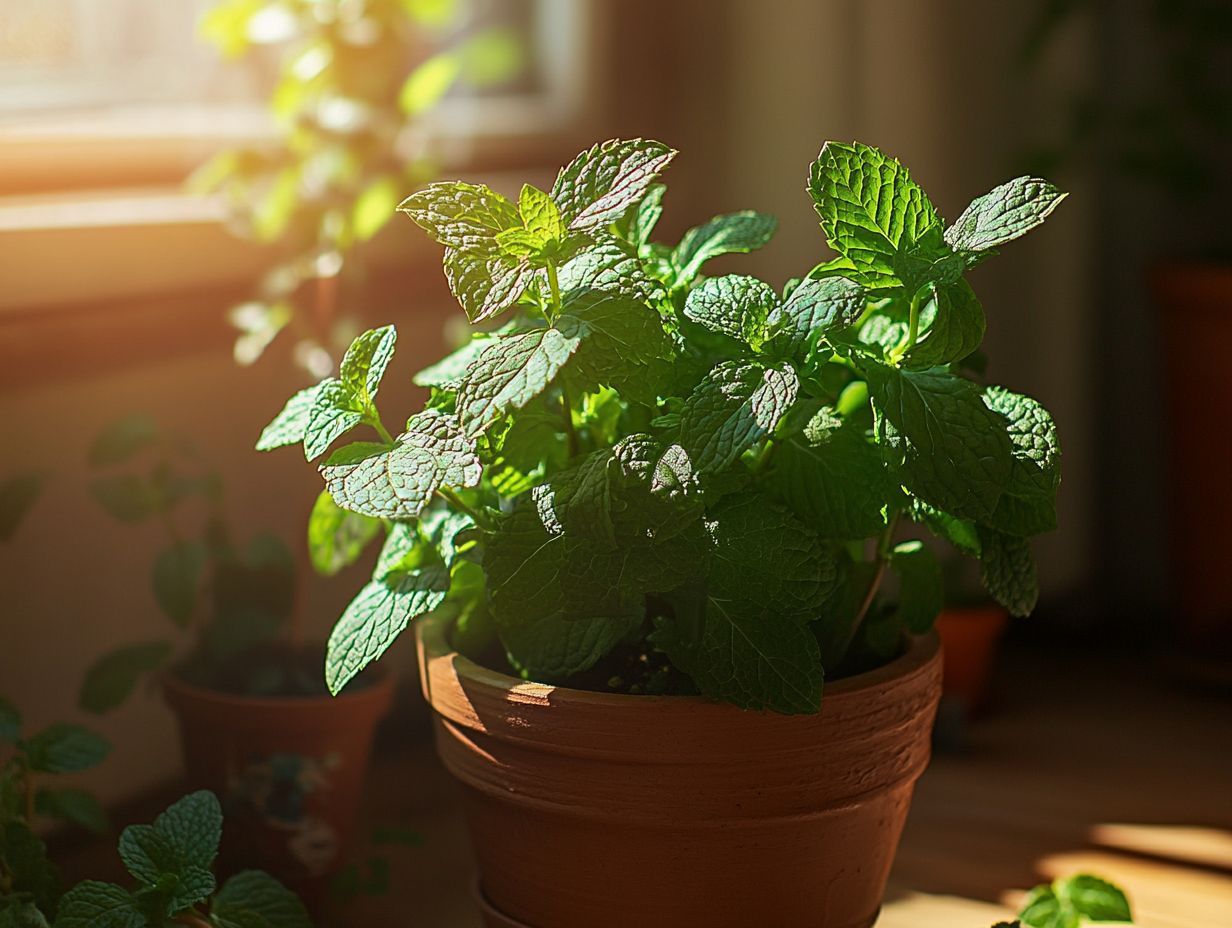
While you can generally trust that peppermint is safe for most people, it s important to remain aware of potential precautions and side effects. This is especially true when using peppermint oil in topical applications.
Possible Risks and Interactions
When considering the use of peppermint oil, be aware of potential risks such as digestive issues, skin irritation, and possible interactions with certain medications.
While peppermint oil is frequently lauded for its soothing qualities, keep in mind that its potency may lead to unforeseen consequences. This is particularly true when mixed with pharmaceutical treatments.
For example, if you re taking anticoagulants or blood pressure medications, make sure to be careful, as peppermint could either amplify or diminish the effectiveness of these drugs. If you re on antacids, you might experience altered absorption rates, impacting how well your medication works.
Given these complexities, it s crucial to consult healthcare professionals before incorporating peppermint oil into your routine. This will help ensure a safe and effective integration into your health regimen while minimizing any potential adverse effects.
Growing and Harvesting Peppermint
Growing and harvesting peppermint can be an incredibly rewarding experience. This aromatic herb flourishes in a variety of conditions, yielding lush, fragrant leaves that are perfect for both culinary delights and medicinal applications.
Embrace the joy of nurturing this versatile plant. Enjoy the multitude of benefits it brings to your kitchen and wellness routine.
Using fresh peppermint enhances your meals and remedies, making every dish and experience more delightful!
Tips for Cultivating and Harvesting
When cultivating and harvesting peppermint, consider essential factors like soil quality, sunlight, and moisture. These elements are key to ensuring you have healthy peppermint leaves ready for delightful extract.
Start with well-draining soil rich in organic matter. Mixing in some compost will boost your growth significantly. Aim for a slightly acidic pH level between 6.0 and 7.0 for the perfect environment. Peppermint loves full sun but appreciates some partial shade during hot months, which helps it thrive.
Don t forget about watering. Keep the soil moist, but avoid letting it become soggy to prevent root rot. When it s time to harvest, aim for just before your plant starts to flower, typically in mid to late summer. That s when the essential oil concentration the amount of aromatic compounds extracted from the leaves reaches its peak, yielding the best flavor and aroma.
Frequently Asked Questions
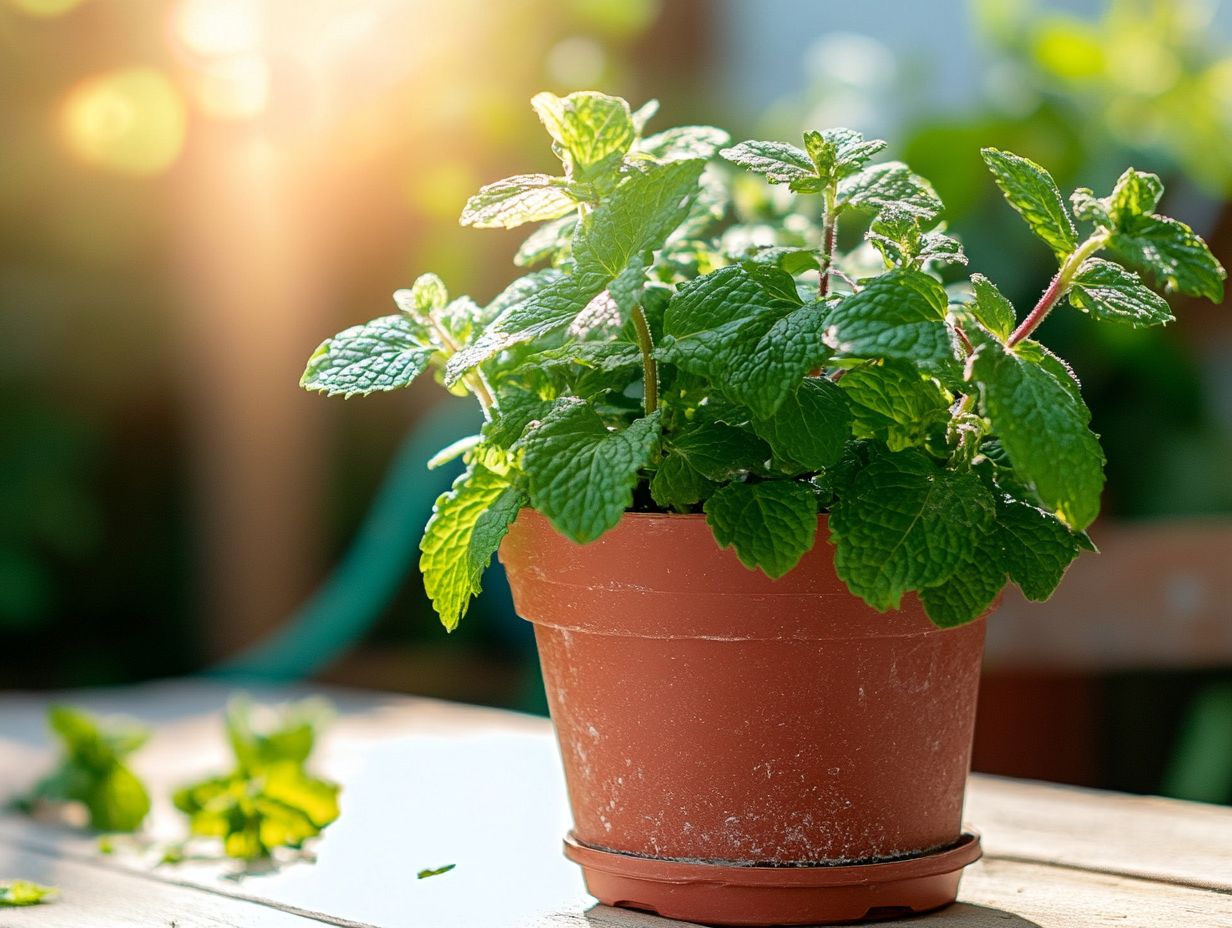
What are the healing powers of peppermint?
Peppermint has been a go-to remedy for centuries! It can help ease digestive issues, relieve headaches, and reduce muscle pain.
How does peppermint help with digestion?
Peppermint has a calming effect on the muscles of the digestive tract, helping ease symptoms of irritable bowel syndrome (IBS) and other digestive disorders.
Can peppermint help with headaches?
Yes, peppermint contains menthol, which has a cooling effect on the skin and can help ease tension headaches and migraines.
In what forms can peppermint be consumed for its healing powers?
You can consume peppermint in different forms, including tea, essential oil, capsules, or as an ingredient in food and drinks.
Are there any potential side effects of using peppermint for its healing powers?
While generally safe, too much peppermint can cause side effects like heartburn, nausea, and allergic reactions in some individuals. Use peppermint in moderation, and consult with a medical professional if you have concerns.
Can peppermint be used for topical applications?
Yes, peppermint oil can be applied topically to relieve muscle pain and tension. However, dilute the oil properly and do a patch test beforehand to avoid skin irritation.
Try growing your own peppermint at home and enjoy its fresh flavor in your dishes!


